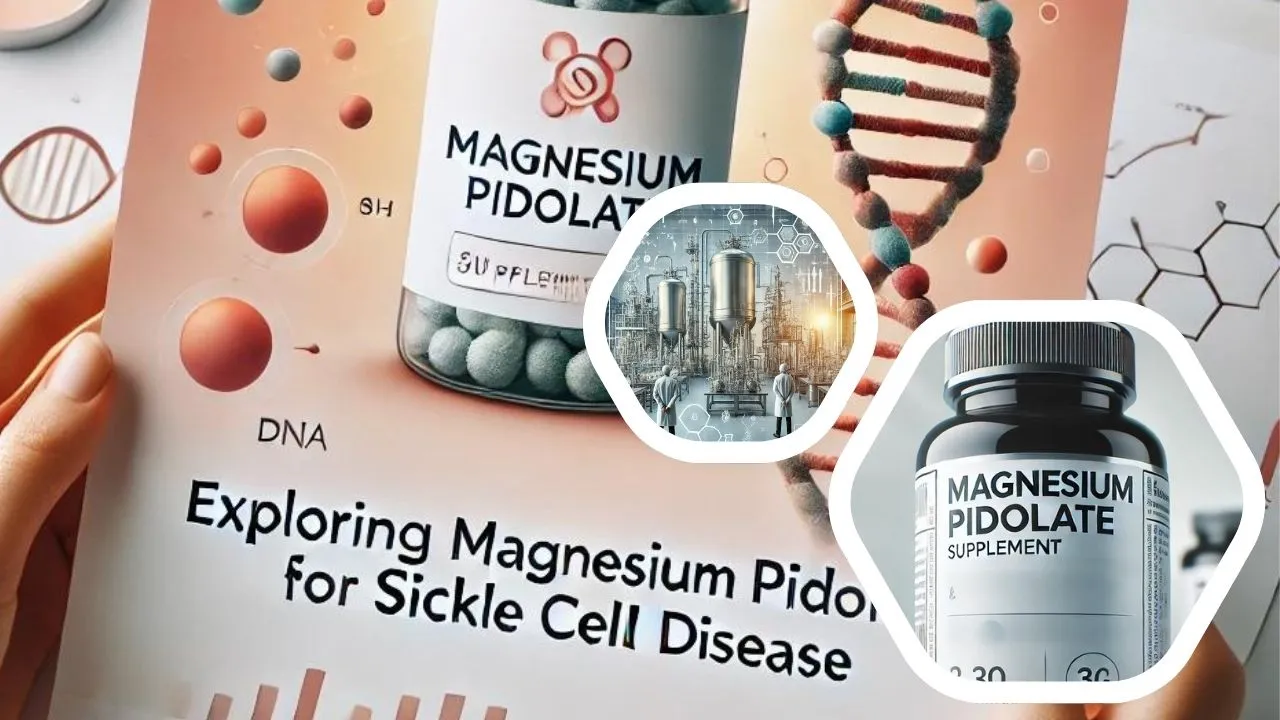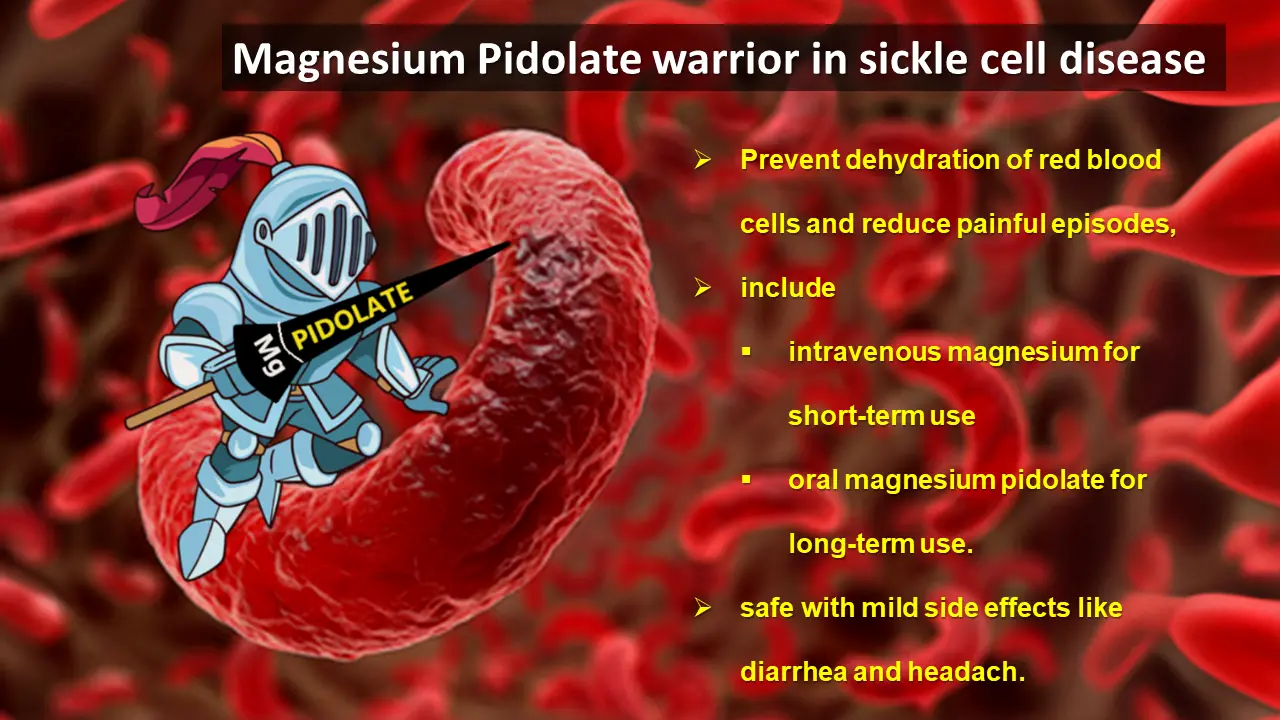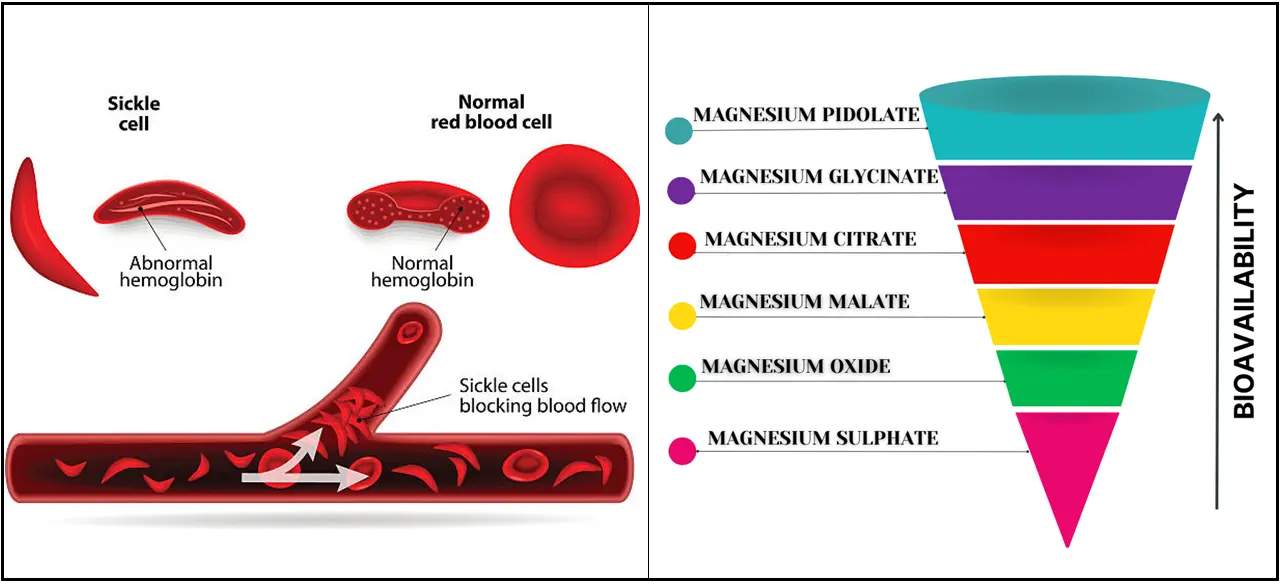Exploring Magnesium Pidolate for Sickle Cell Disease in Children
Sickle cell disease is a serious genetic condition that affects red blood cells. It is an inherited blood disorder. Magnesium pidolate, a specific type of magnesium supplement, has emerged as a potential candidate for treating sickle cell disease in children [2]. These cells become sickle-shaped, causing blockages in blood flow and leading to painful episodes and other complications [1]. While there’s no cure for sickle cell anaemia, treatments aim to manage symptoms and improve quality of life.
Abnormal hemoglobin levels, sometimes detected through blood tests, can indicate various underlying health conditions. While sickle cell disease affects red blood cells, high white blood cell counts may occur and worsen complications in some patients. This blog explores the current research on magnesium pidolate and its role in sickle cell disease treatment.
Why Magnesium for Sickle Cell Disease?
Healthy red blood cells are flexible and round, allowing them to travel smoothly through blood vessels. In sickle cell disease, a genetic mutation causes red blood cells to become rigid and sickle-shaped. These sickle cells get stuck in blood vessels, blocking oxygen flow and causing pain, inflammation, and organ damage [3].
Magnesium is a mineral crucial for various bodily functions, including muscle and nerve function. Adults should be aware of the recommended daily magnesium intake: 420 mg for males and 350 mg for females. Delivered directly into a vein, intravenous magnesium is used in hospitals to treat severe magnesium deficiency and certain medical emergencies [4]. Research suggests oral magnesium supplements could help keep sickle red blood cells hydrated and reduce the frequency of painful episodes for people with sickle cell disease.

Studies suggest it might play a role in sickle cell disease by:
Hydration: Magnesium therapy may help prevent dehydration of red blood cells, a factor contributing to sickling.
Vasodilation: It might act as a vasodilator, relaxing blood vessels and potentially improving blood flow.
Inflammation: Magnesium possesses anti-inflammatory properties, potentially reducing inflammation associated with sickle cell disease complications.
Magnesium Pidolate: The saviour
Made from pidolic acid, magnesium pidolate is a mineral supplement providing 8.6% elemental magnesium by weight. Among magnesium supplements, magnesium pidolate is touted for its high bioavailability, meaning the body may absorb it more efficiently [5]. Boasting a reported 40-60% bioavailability, magnesium pidolate is a highly absorbable form of magnesium that may be beneficial for various health needs.
Research on Magnesium Pidolate for sickle cell disease:
Research on Magnesium Pidolate benefits for sickle cell disease is ongoing, with mixed results. Long-term use of oral magnesium pidolate in sickle cell disease studies did not lessen pain severity or directly alter red blood cell properties [6].
Research suggests sickle cell disease treatment with oral magnesium pidolate supplementation could help prevent dehydration in sickle red blood cells, potentially reducing the frequency of painful episodes for people with sickle cell disease. There is a link between low magnesium levels and increased sickling, potentially due to dehydration of red blood cells which can worsen vaso-occlusion in sickle cell disease [7].

Here’s a breakdown of current findings:
Promising signs:
A small study showed sickle cell disease children who took oral magnesium pidolate for 6 months experienced fewer painful episodes compared to a placebo group.
Limited evidence:
Larger studies are needed to confirm these initial findings and assess the long-term effects of magnesium pidolate on sickle cell disease.
Intravenous magnesium:
Studies on intravenous magnesium for pain crisis management during hospitalization have shown some promise in reducing hospital stays. However, more research is necessary to determine its long-term role.
Magnesium pidolate in addressing sickle cell:
Magnesium Pidolate in paediatric sickle cell disease:
Initial studies explored the potential of magnesium pidolate to prevent dehydration in sickle red blood cells in children. However, these haven’t conclusively demonstrated a reduction in pain severity or changes in red blood cell properties [8].
Magnesium Pidolate in Adult Patients sickle cell disease
Research on the use of magnesium pidolate in adults with sickle cell disease mirrors the findings in children. These studies haven’t shown a definitive reduction in pain or changes in red blood cell morphology. While conclusive evidence for pain reduction is lacking, some studies suggest a link between Hemoglobinopathies and magnesium therapy.
Management During Pregnancy:
There’s currently a dearth of data on the safety and efficacy of magnesium pidolate specifically for pregnant women with sickle cell disease. Due to this lack of conclusive evidence, its use during pregnancy is not currently recommended. Pregnant women with sickle cell disease should prioritize established prenatal care with a healthcare professional.

Important Considerations
While the initial research on magnesium pidolate for sickle cell disease is promising, it’s crucial to remember:
Limited evidence: Larger studies are needed to confirm its effectiveness.
Talk to your doctor: Magnesium pidolate can interact with other medications. It’s essential to discuss it with your child’s doctor before starting supplementation.
Not a cure: Long-term studies on oral magnesium pidolate for sickle cell disease haven’t shown reduced pain severity or changes in red blood cells, but it appears safe with minimal side effects like diarrhea and headaches. Magnesium pidolate is not a cure for sickle cell disease but a potential complementary therapy alongside standard treatment plans.
Focus on Overall Management
sickle cell disease management involves a multi-pronged approach, including:
Hydroxyurea:
This medication helps increase the production of foetal hemoglobin, which can reduce sickling.
Pain management:
Medications and strategies to manage pain during crisis episodes.
Hydration:
Staying well-hydrated is crucial for preventing sickling.
Vaccinations:
Regular vaccinations are essential to prevent infections.
Supportive care:
Psychological support and nutritional guidance can significantly improve quality of life.
Magnesium pidolate benefits
Supporting Muscle Health:
A rise in magnesium within muscle cells acts as a signal to initiate muscle contraction. Research suggests magnesium pidolate may help with muscle function, potentially reducing cramps, spasms, and aches.
Promoting Relaxation and Sleep:
Some studies explore the use of magnesium pidolate for stress management and relaxation, potentially improving sleep quality and reducing difficulty falling asleep in those with insomnia. [9]
Maintaining Bone Density:
Magnesium plays a vital role in bone health, and magnesium pidolate supplementation might be beneficial for maintaining bone density.
Magnesium pidolate for anxiety:Studies explore the potential benefits of magnesium pidolate for mental well-being, including improved cognitive function and reduced stress and anxiety [10].
Energy metabolism:
Magnesium is involved in numerous enzymatic reactions essential for energy production. Supplementation may be helpful for individuals with magnesium deficiency experiencing fatigue.
Electrolyte Balance and Energy Production:
Magnesium pidolate, like other magnesium forms, may contribute to electrolyte balance and support healthy energy metabolism within cells.
Magnesium pidolate for migraines:
magnesium pidolate, with its high bioavailability, may be fast-acting in reversing headaches caused by magnesium deficiency.
Athletes may benefit from magnesium pidolate supplementation, as research suggests it can enhance sports performance by supporting muscle function, energy production, reducing fatigue, and promoting faster recovery.
Magnesium pidolate in dysmenorrhea:
Magnesium is a mineral involved in muscle relaxation and prostaglandin regulation. Prostaglandins, when produced in excess, can contribute to menstrual cramps. Some studies have shown that magnesium supplementation, including magnesium pidolate, may help reduce the intensity and duration of menstrual pain [11].
Magnesium pidolate in the treatment of seasonal allergic rhinitis:
Use of magnesium pidolate affects intensity of rhinorrhea, daily consumption of Kleenex tissues, number of sneezes in a day, intensity of lacrimation. It observed reduced symptoms like runny nose, tissue usage, sneezing frequency, and eye watering in the magnesium pidolate group compared to the placebo.
Magnesium pidolate dosage
When taken at recommended amounts, magnesium pidolate is generally well-tolerated by most healthy adults. Studies suggest oral magnesium supplementation for sickle cell disease may be well-tolerated with minimal side effects like diarrhea and headaches. Combining magnesium with muscle relaxants might intensify the muscle relaxant’s side effects. Nutritional management for sickle cell disease focuses on maintaining hydration, consuming a balanced diet rich in essential nutrients, and potentially including specific supplements like folate to support overall health and reduce complications.
Conclusion
Looking for high-quality magnesium pidolate (CAS 135701-98-3)? WBCIL is a leading manufacturer and exporter of this mineral active ingredient. Magnesium pidolate shows promise as a potential complementary therapy for managing SCD in children. However, more research is necessary to solidify its role. It’s crucial to discuss magnesium pidolate with your child’s doctor before starting supplementation to ensure safety and integrate it within their overall SCD management plan.
1. What Is Sickle Cell Disease? National Heart, Lung and Blood Institute. https://www.nhlbi.nih.gov/health/sickle-cell-disease
2. De Franceschi, , Bachir, , Galacteros, , Tchernia, , Cynober, , Neuberg, , Beuzard, and Brugnara, (2000), Oral magnesium pidolate: effects of long-term administration in patients with sickle cell disease. British Journal of Haematology, 108: 284-289. https://doi.org/10.1046/j.1365-2141.2000.01861.x
3. Than NN, Soe HHK, Palaniappan SK, Abas AB, De Franceschi L. Magnesium for treating sickle cell disease. Cochrane Database Syst Rev. 2017 Apr 14;4(4):CD011358. doi: 10.1002/14651858.CD011358.pub2. Update in: Cochrane Database Syst Rev. 2019 Sep 09;9:CD011358. doi: 10.1002/14651858.CD011358.pub3. PMID: 28409830; PMCID: PMC6478130. https://www.ncbi.nlm.nih.gov/pmc/articles/PMC6478130/
4. Than N, Soe H, Palaniappan SK, Abas ABL, De Franceschi L. Magnesium for treating sickle cell disease. Cochrane Database of Systematic Reviews 2019, Issue 9. Art. No.: CD011358. DOI: 10.1002/14651858.CD011358.pub3. https://www.cochrane.org/CD011358/CF_magnesium-treating-sickle-cell-disease
5. Wikipedia contributors. Magnesium pidolate. Wikipedia, The Free Encyclopedia. April 19, 2024, 08:04 UTC. Available at: https://en.wikipedia.org/w/index.php?title=Magnesium_pidolate&oldid=1219692917.
6. National Center for Biotechnology Information. PubChem Compound Summary for CID 18601084, Magnesium pidolate. https://pubchem.ncbi.nlm.nih.gov/compound/Magnesium-pidolate
7. Magnesium Pidolate, Chemspider, http://www.chemspider.com/Chemical-Structure.8014340.html
- Brigitta Ursula Mueller, Marlen Dinu, Susan Kurth, Roz Bryant, Elizabeth Mullen, Yan Jinrong, Donald H. Mahoney, Carlo Brugnara; The Safety and Efficacy of Oral Magnesium Pidolate in Children with Hemoglobin SC Disease.. Blood2005; 106 (11): 3777. https://ashpublications.org/blood/article/106/11/3777/121935/The-Safety-and-Efficacy-of-Oral-Magnesium-Pidolate
9. Maier JA, Pickering G, Giacomoni E, Cazzaniga A, Pellegrino P. Headaches and Magnesium: Mechanisms, Bioavailability, Therapeutic Efficacy and Potential Advantage of Magnesium Pidolate. Nutrients. 2020 Aug 31;12(9):2660. doi: 10.3390/nu12092660. PMID: 32878232; PMCID: PMC7551876. https://pubmed.ncbi.nlm.nih.gov/32878232/
10. Maier JA, Pickering G, Giacomoni E, Cazzaniga A, Pellegrino P. Headaches and Magnesium: Mechanisms, Bioavailability, Therapeutic Efficacy and Potential Advantage of Magnesium Pidolate. Nutrients. 2020; 12(9):2660. https://doi.org/10.3390/nu12092660
11. Benassi L, Barletta FP, Baroncini L, et al. Effectiveness of magnesium pidolate in the prophylactic treatment of primary dysmenorrhea. Clinical and Experimental Obstetrics & Gynecology. 1992 ;19(3):176-179. PMID: 1451282. https://europepmc.org/article/med/1451282
Cipolla C, Occhionero T, Orciari P, Lugo G, D’Antuono G. Magnesium pidolate in the treatment of seasonal allergic rhinitis. Preliminary data. Magnes Res. 1990 Jun;3(2):109-12. PMID: 2133624. https://pubmed.ncbi.nlm.nih.gov/2133624/
Magnesium pidolate may help prevent dehydration of sickle red blood cells, reduce painful episodes, improve blood flow by acting as a vasodilator, and reduce inflammation associated with sickle cell disease complications.
Research on magnesium pidolate for sickle cell disease is ongoing. Some small studies have shown promising results, such as reduced painful episodes in children taking magnesium pidolate. However, larger studies are needed to confirm these findings and assess long-term effects.
Magnesium pidolate is generally well-tolerated when taken at recommended amounts. Common side effects may include diarrhea and headaches. It is essential to discuss any supplementation with a healthcare provider to ensure it is safe and appropriate for the child.
No, magnesium pidolate is not a cure for sickle cell disease. It should be considered a complementary therapy alongside standard treatments such as hydroxyurea, pain management, hydration, vaccinations, and supportive care.
Magnesium pidolate is typically taken orally in supplement form. The specific dosage and administration should be determined by a healthcare provider based on the child’s needs and medical condition.
Magnesium pidolate can interact with certain medications, such as muscle relaxants, intensifying their side effects. It is crucial to consult with a healthcare provider before starting magnesium pidolate to ensure it does not interfere with any other treatments.
